
Introduction: The Rise of No-Code Website Builders
In today’s fast-paced digital world, having an online presence is crucial for individuals and businesses alike. However, the idea of building a website from scratch can seem overwhelming, especially if you’re not tech-savvy. Thankfully, the advent of no-code website builders has revolutionized the way people create websites. With these powerful tools, anyone can design, develop, and launch a professional website without writing a single line of code.
Also read: Make Money with Blog: Top 9 Blog Advertising Networks in 2025
As we move into 2025, the demand for no-code solutions has skyrocketed. These tools allow entrepreneurs, bloggers, creatives, and small business owners to bring their ideas to life on the web, regardless of their technical expertise. Whether you’re looking to create a personal blog, a portfolio, an online store, or a business website, no-code builders offer a simple yet effective solution.
In this article, we’ll explore the top 10 no-code website builders for 2025, highlighting their features, benefits, and the reasons why they stand out in the crowded market. We will also provide a step-by-step guide on how to create a website with these tools and offer tips on how to make your site SEO-friendly.
What is a No-Code Website Builder?
A no-code website builder is an online tool that allows users to create and design websites without needing to know any programming languages or technical skills. These platforms provide a simple, drag-and-drop interface where users can add and customize elements like text, images, videos, buttons, and forms with ease. Instead of writing HTML, CSS, or JavaScript, users can focus entirely on the design and content of their site.
No-code website builders are designed to be user-friendly, offering intuitive workflows that guide you through the process of building a website. They come with pre-designed templates, customizable layouts, and integrated tools for handling tasks like hosting, SEO, and e-commerce. These features make them an ideal choice for beginners and small business owners who need to create a website quickly and affordably.
Why Choose a No-Code Website Builder?

No Technical Skills Required
One of the most significant advantages of using a no-code website builder is that you don’t need any coding knowledge. The platform takes care of all the technical aspects, such as server management, database configuration, and code implementation, allowing you to focus on the visual and functional aspects of your site. Whether you’re a designer, writer, or entrepreneur, no-code builders make web development accessible to everyone.
Cost-Effective Solutions
Hiring a professional developer or designer to build a website can be expensive. The cost of development, design, and maintenance can easily run into thousands of dollars. No-code website builders, however, are an affordable alternative. Many platforms offer free plans, with premium features available at a fraction of the cost of hiring a developer. This makes no-code website builders an excellent choice for individuals, startups, and small businesses with limited budgets.
Quick Launch and Setup
Creating a website from scratch with traditional web development methods can take weeks or even months, depending on the complexity of the project. No-code website builders streamline the process, allowing you to design and launch your website in just a few hours or days. This speed is particularly beneficial for those who need to get their business or project online quickly.
Complete Customization
Despite being easy to use, no-code website builders offer a high degree of customization. You can personalize your site’s design by adjusting colors, fonts, layouts, and other elements to match your brand’s identity. Some platforms also allow you to add custom code if you need more advanced features or design options, providing flexibility for those with more experience.
Top 10 No-Code Website Builders for 2025
Here are the top 10 no-code website builders that have proven to be the best in 2025, offering a combination of user-friendly interfaces, powerful features, and customization options.
1. Wix
Wix remains one of the most popular and versatile no-code website builders in 2025. Known for its drag-and-drop functionality and extensive template library, Wix allows users to create anything from personal blogs to large-scale e-commerce websites. The platform also offers AI-powered tools to help you create a website quickly based on your preferences, making it ideal for beginners.
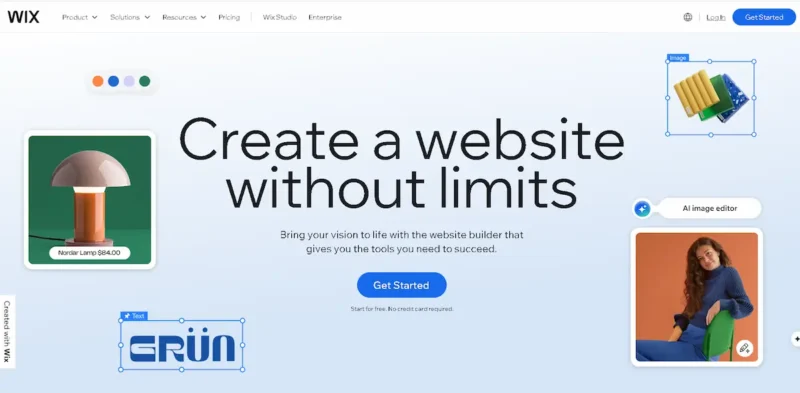
Key Features:
- Drag-and-drop editor
- eCommerce capabilities
- Wide range of templates and design elements
- SEO tools and analytics
- Wide variety of customizable templates
- Wix ADI (Artificial Design Intelligence) for automatic website creation
- SEO tools and marketing features
- Mobile optimization
- Free plan available
Pros:
- Extremely easy to use for beginners
- Large selection of apps and integrations
- Excellent customer support
Cons:
- Limited flexibility with some templates
- More expensive premium plans
2. Squarespace
Squarespace is a well-established platform known for its sleek, professional designs. It’s an excellent choice for creatives, photographers, and artists who want to showcase their work in a visually appealing way. Squarespace offers a range of customizable templates and robust tools for building and managing your website.

Key Features:
- Beautiful, award-winning templates
- Built-in blogging and e-commerce tools
- SEO optimization tools
- Mobile-responsive designs
- 24/7 customer support
- Drag-and-drop editor
- Advanced image editing options
Pros:
- Beautiful, high-quality templates
- Great for visual-based websites
- All-in-one platform (hosting, domain registration, and SSL included)
Cons:
- Less flexibility compared to some competitors
- Can be a bit pricey
3. Weebly
Weebly is a beginner-friendly website builder that provides an intuitive drag-and-drop interface. It’s particularly well-suited for small businesses and entrepreneurs who want to quickly create an online store. Weebly integrates seamlessly with Square for payment processing, making it an excellent option for eCommerce.
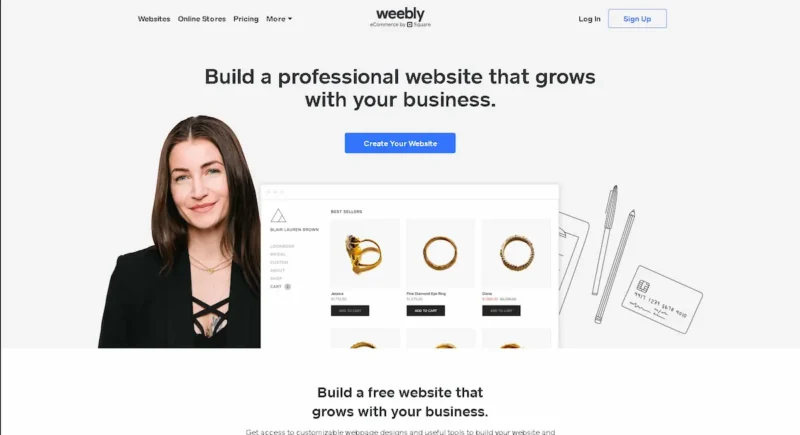
Key Features:
- Drag-and-drop editor
- Integrated e-commerce tools
- Mobile-responsive themes
- SEO and marketing tools
- Affordable pricing plans
- Free plan available
Pros:
- Affordable pricing
- Simple interface
- Built-in e-commerce tools
Cons:
- Limited design flexibility
- Less customization compared to other platforms
4. Shopify
For anyone looking to build a full-fledged online store, Shopify is the leading no-code website builder in the e-commerce space. Shopify offers powerful features for inventory management, payment processing, and order fulfillment. It also has a large app marketplace to extend the functionality of your store.

Key Features:
- Industry-leading e-commerce tools
- Multiple payment gateway options
- Wide selection of customizable themes
- App marketplace for extended functionality
- SEO and marketing tools
- Multi-channel selling (including social media platforms)
Pros:
- Excellent for scaling e-commerce businesses
- Easy to integrate with third-party apps
- 24/7 customer support
Cons:
- Expensive for small businesses
- Transaction fees (unless you use Shopify Payments)
5. Webflow
Webflow is a more advanced no-code website builder that gives users greater design flexibility. While it is beginner-friendly, Webflow allows for custom animations, interactions, and integrations that are typically reserved for professional developers. This makes it ideal for designers who want more control over their website’s design.
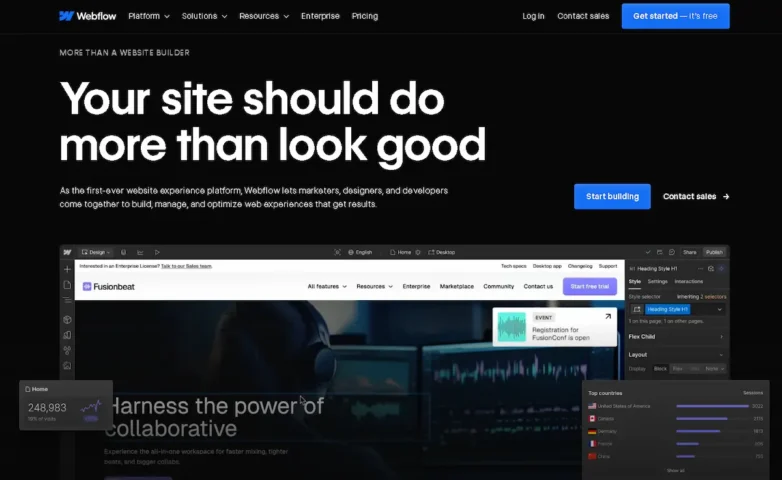
Key Features:
- Full design flexibility
- CMS and e-commerce tools
- Custom animations and interactions
- Hosting and security included
- High level of design customization
- Built-in CMS (Content Management System)
- Responsive design tools
- SEO tools and integrations
Pros:
- Great for advanced users
- Extremely flexible
- Highly customizable
Cons:
- Steeper learning curve
- Pricing can be higher than other platforms
6. Zyro
Zyro is a simple, no-frills website builder that emphasizes ease of use. It’s perfect for small businesses and individuals who want to create a website quickly without any fuss. Zyro offers a variety of templates and an intuitive editor to help you design a professional site.
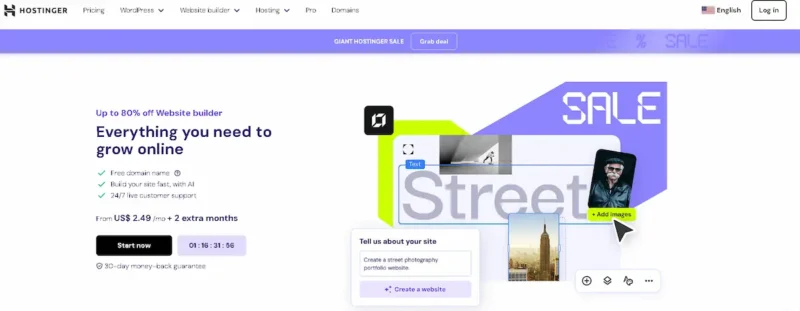
Key Features:
- Easy-to-use drag-and-drop interface
- AI-powered tools for design and content creation
- SEO optimization features
- Affordable pricing plans
- Mobile-friendly designs
- AI-powered website builder
- E-commerce tools
- Blog integration
Pros:
- Easy to use for beginners
- Quick setup with AI assistance
- Affordable pricing
Cons:
- Limited advanced customization
- Fewer templates than competitors
7. Carrd
Carrd – Simple, free, fully responsive one-page sites for pretty much anything is a minimalist website builder that’s perfect for creating simple landing pages, portfolios, or personal sites. With its intuitive drag-and-drop interface, Carrd makes it easy to launch a website in just a few minutes.

Key Features:
- Simple, one-page website builder
- Affordable pricing plans
- Easy drag-and-drop interface
- Integration with third-party tools
- Mobile-responsive designs
- Simple, minimalistic templates
- Fast loading times
- Free plan available
Pros:
- Ideal for one-page websites
- Simple, no-fuss interface
- Very affordable
Cons:
- Limited functionality for larger websites
- Fewer customization options compared to other builders
8. Strikingly
How To Make a Website – Free Website Builder | Strikingly is a no-code website builder that focuses on creating one-page websites. It’s perfect for personal projects, event pages, and portfolios. Strikingly offers a range of stunning templates and powerful tools to help you build a beautiful website quickly.

Key Features:
- One-page website builder
- User-friendly drag-and-drop editor
- Built-in e-commerce tools
- Mobile-optimized designs
- Social media integration
- Simple, modern templates
- Integrated analytics
- SEO tools
Pros:
- Fast website creation
- Good for personal branding
- Affordable pricing
Cons:
- Limited functionality for larger sites
- Less flexibility with design
9. Bubble
Bubble is a no-code platform that allows you to build fully functional web applications, not just websites. It’s perfect for users looking to create complex apps without coding.
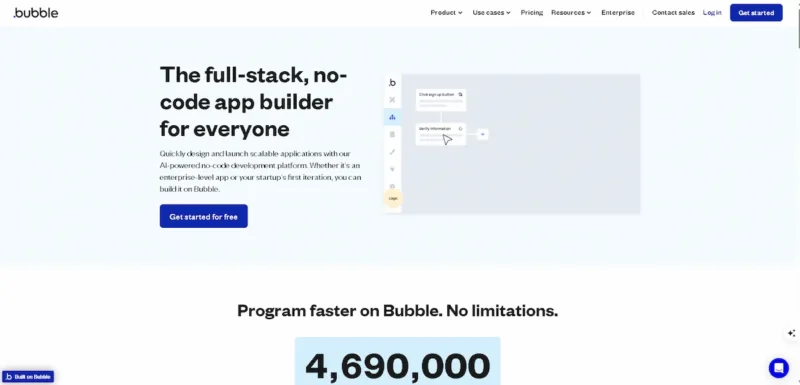
Key Features:
- Drag-and-drop visual editor
- Full application-building capabilities
- Integrated database and logic
- User authentication and API integrations
Pros:
- Ideal for web apps and complex projects
- High level of customization
- Strong community and resources
Cons:
- Steep learning curve
- Not as suited for simple websites
10. WordPress
WordPress.com is a hosted version of the popular WordPress platform. It allows you to create a website without coding, using a simple block editor. WordPress.com is great for bloggers, small businesses, and anyone who wants a straightforward website with a lot of customization options.

Key Features:
- Block-based editor for easy content creation
- Built-in blogging and e-commerce features
- Mobile-responsive themes
- Extensive plugin library
- Free and paid plans available
- WordPress as the content management system
- Drag-and-drop page builder (Elementor)
- Customizable templates
Pros:
- Great for all types of websites (blog, business, portfolio)
- Flexible design options
- Large support community
Cons:
- Requires WordPress hosting
- Somewhat complex for complete beginners
Comparing No-Code Website Builders: Features and Benefits
When it comes to choosing a no-code website builder, the right choice depends on your specific needs. Some platforms, like Shopify and Wix, excel at e-commerce, while others, like Squarespace and Webflow, are more focused on design and customization. Consider factors such as your budget, the complexity of your site, and whether you need advanced features like e-commerce or SEO optimization.
How to Choose the Right No-Code Website Builder for Your Needs
Selecting the right no-code website builder involves evaluating your specific needs, budget, and desired features. Here’s a step-by-step guide to assist you in making an informed decision:
1. Identify Your Needs
Determine the primary purpose of your website:
- Personal Blog or Portfolio: Platforms like Squarespace offer elegant templates ideal for showcasing creative work. Veitopia
- E-commerce Store: If you’re aiming to sell products online, Shopify provides comprehensive e-commerce tools. Veitopia
- Business Website: For a professional business presence, Wix offers a range of customizable templates suitable for various industries. Veitopia
2. Budget Considerations
Assess your financial resources:
- Free Plans: Some platforms, like Wix and Carrd, offer free plans with basic features. Veitopia
- Premium Plans: For advanced features, consider the pricing tiers of each platform. For instance, Squarespace starts at $16/month, while Shopify begins at $29/month. Veitopia
3. Ease of Use
Evaluate the user interface:
- Beginner-Friendly: Wix and Weebly are known for their intuitive drag-and-drop editors, making them suitable for those new to website building. Company Idea
- Advanced Features: Webflow offers more design flexibility but may have a steeper learning curve. Company Idea
4. Design Flexibility
Consider customization options:
- Template Variety: Squarespace provides high-quality templates ideal for creatives. Veitopia
- Customization: Webflow allows for advanced design and development features, offering greater control over your site’s appearance. Company Idea
5. Support and Resources
Ensure adequate assistance:
- Customer Support: Platforms like Shopify and Squarespace offer robust customer support. Company Idea
- Community and Tutorials: Webflow has an active community and extensive tutorials, which can be beneficial for users seeking to maximize the platform’s capabilities. Company Idea
6. Additional Considerations
- SEO Capabilities: Ensure the platform supports SEO best practices to enhance your site’s visibility.
- Mobile Responsiveness: Verify that the platform’s templates are mobile-friendly to reach a broader audience.
- Scalability: Consider whether the platform can accommodate your website’s growth over time.
By carefully evaluating these factors, you can select a no-code website builder that aligns with your goals and resources, ensuring a successful online presence.
Steps to Create Your Website with No-Code Tools
Creating a website using no-code tools is an accessible and efficient way to establish an online presence without the need for programming skills. Here’s a step-by-step guide to help you through the process:
1. Choose the Right No-Code Platform
Select a no-code website builder that aligns with your goals and technical comfort level. Popular options include:
- Wix: Known for its user-friendly drag-and-drop interface and a wide range of customizable templates, making it ideal for small businesses and personal sites. ZeBall
- Webflow: Offers advanced design capabilities with a visual editor, suitable for those seeking more control over their site’s layout and interactions. Seattle New Media
- Squarespace: Provides elegant designs and robust features, ideal for creatives, portfolios, and e-commerce sites. Medium
2. Sign Up and Select a Template
After choosing a platform, create an account and browse through the available templates. Select one that best fits your website’s purpose, whether it’s a blog, portfolio, or online store.
3. Customize Your Website
Utilize the platform’s editor to personalize your site:
- Layout: Arrange sections and elements to suit your content structure.
- Fonts and Colors: Choose typography and color schemes that align with your brand identity.
- Images and Media: Upload relevant images, videos, and other media to enhance visual appeal.
4. Add Essential Pages
Ensure your website includes key pages such as:
- Home: An overview of what visitors can expect.
- About: Information about you or your business.
- Services/Products: Details of what you offer.
- Contact: Ways for visitors to get in touch.
5. Integrate Additional Features
Enhance functionality by adding:
- Blog: To share updates and engage with your audience.
- E-commerce Capabilities: If selling products, set up product pages, shopping carts, and payment gateways.
- SEO Tools: Optimize your site for search engines to improve visibility.
6. Preview and Test Your Website
Before publishing, preview your site to ensure it displays correctly on various devices (desktops, tablets, smartphones). Test all links, forms, and interactive elements to confirm they function properly.
7. Publish Your Website
Once satisfied with your design and content, publish your site. Most platforms offer hosting services and options to connect a custom domain name.
8. Maintain and Update Regularly
Keep your website fresh by regularly updating content, adding new features, and monitoring performance analytics to understand visitor behavior and improve user experience.
By following these steps, you can create a professional and functional website without any coding knowledge, allowing you to focus on delivering value to your audience.
SEO and No-Code Website Builders: Can You Rank High?
Yes! Most no-code website builders are optimized for SEO, offering built-in tools to help improve your rankings. Ensure you:
- Use relevant keywords in your content.
- Customize meta tags, titles, and descriptions.
- Add alt text for images.
- Create a mobile-responsive design.
Best Practices for Optimizing Your Website
- Use SEO tools: Most platforms come with SEO settings, so make sure to optimize your website for search engines.
- Mobile optimization: Ensure your website looks great on all devices.
- Fast loading speed: Compress images and use caching to improve your website’s loading times.
Youtube Video: BEST Website Builder 2025 (My TOP Recommendation)
Summarize
Conclusion: Why No-Code Builders Are the Future of Web Development
No-code website builders have democratized web design, making it accessible to anyone with an idea and an internet connection. Whether you’re an entrepreneur, artist, or small business owner, these platforms allow you to bring your vision to life without the need for technical skills. As we move into 2025, no-code website builders will continue to grow in popularity, offering more features, flexibility, and ease of use than ever before.
Frequently Asked Questions (FAQs)
Can I create a website without coding?
Yes, no-code website builders are specifically designed for users without coding knowledge.
Are no-code website builders free?
Many platforms offer free plans with the option to upgrade for additional features.
Can I create an online store using no-code tools?
Yes, platforms like Shopify, Wix, and Squarespace allow you to build e-commerce websites easily.
Are no-code websites SEO-friendly?
Most no-code website builders come with built-in SEO tools to help optimize your site for search engines.
How long does it take to build a website with no-code tools?
You can create a basic website in just a few hours, depending on the platform and the complexity of your site.




